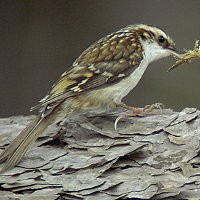- Home
- FAQs
- Customer Video Gallery
- Customer Photo Gallery
- Bird Facts
- Bird Food Blog
- Bird Information
- Feeding Advice
- Small Animal Information
- A to Z of Guinea Pigs
- A to Z of Hamsters
- A to Z of Rabbits
- Basic Care for Guinea Pigs
- Basic Care for Hamsters
- Basic Care for Rabbits
- Basic care for Chinchillas
- Basic care for Ferrets
- Basic care for Gerbils
- Basic care for Mice
- Basic care for Rats
- Buying a Healthy Small Animal
- Does your Reptile need a Licence
- Equipment for Ferrets
- Equipment for Hamsters
- Equipment for Mice
- Equipment for your Chinchilla
- Equipment for your Gerbil
- Equipment for your Guinea Pig
- Equipment for your Rabbit
- Keeping a House Rabbit
- Dog Information
- Cat Information
- Customer Information
- Fat Balls
- Suet Pellets
- Straights
- Seed Mixes
- Suet Treats
- Mealworms
- Bird Feeders
- My Account

| Scientific Name | Certhia familiaris |
| Breeding | April |
| Fledge Days | 14-15 |
| Incubation Days | 14-15 |
| Lifespan | 2 years |
| Number of Clutches | 2 |
| Number of Eggs | 3-9 |
| Size | 12.5cm |
| Weight | 8 - 11 g |
| Wingspan | 19cm |
Bird Family : Treecreepers
Treecreeper Facts - Information About Treecreeper
Treecreeper - Certhia Familiaris
The Treecreeper is a woodland specialist, it is cryptically patterned and often hard to find as it is small, well camouflaged and has a very quiet high pitched call. On the upside, no other British bird looks like it apart from its continental cousin that is extremely rare in the UK.
Identification
- Sexes are alike, young birds are also like the adults.
- Treecreepers are easy to identify, the hardest part is finding them.
- Treecreepers do exactly what it says on the tin, they creep up trees like little mice.
- Once they have reached where they are going they will then fly down to the base of the next tree and start climbing again.
- They are cryptically patterned, brown above and white below.
- Treecreepers are small, around 13 cms in length; this includes its fairly long tail.
- Tail is stiff, pointed and brown in colour.
- Rest of the upperparts are a combination of brown and buff with white flecking.
- Wing feathers are tipped buff and white.
- The head shows a brown crown that is intensely flecked buff/white.
- The Treecreeper has an obvious white eyebrow, brown specked ear coverts with small pale patch and dark lores.
- The underside from chin down is white but buffy on the flanks.
- They often appear ‘bull headed’ with very little neck.
- Bill is long, down curved and pale.
- Eye dark, legs pale.
Status and Distribution
The Treecreeper is a very abundant breeding resident in the UK with over 200,000 pairs. The Treecreeper occurs in all counties throughout the UK and Ireland
Habitat/Food
Treecreepers occur in all habitat types throughout the UK, woodlands, parks, gardens, farmland, hedgerows indeed any open country habitat with suitable scrub.
If you have established trees in the garden you may well find a treecreeper, they feed on Insects, especially spiders and on occasions when Insects are hard to find they will eat Seeds.
Song/Call
Call notes; most often a soft metallic buzzing ‘sree’.
Song is a short and tit like, descending trill.
The following food is favoured by Treecreeper















